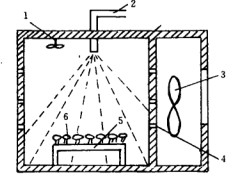Model of microwave drying drying heat transfer process in yellow peach
On the basis of Fick diffusion model and conduction model, considering the effects of heat and moisture diffusion, direct evaporation of water and internal heat source, the internal mass and heat transfer model of microwave drying yellow peach was obtained. The model is simulated by explicit finite difference method, and the calculated values are basically consistent with the measured values.
Key words: microwave drying equipment, yellow peach, model

In the past, most of the mass and heat transfer models used Fick diffusion law and transfer equation directly in the study of drying of agricultural materials. In the model, the effects of temperature gradient on water diffusion and evaporation on temperature change are neglected, and the mass and heat parameters are assumed to be constant. These will lead to great limitations in model and simulation conclusions.
Microwave drying of fruits and vegetables is very fast, and its mechanism is different from that of hot air drying. There are moisture vapor diffusion and heat-humidity effects in drying materials, but no such mass-heat model has been reported. In this paper, a mathematical model for microwave drying of internal heat transfer in yellow peach is established and numerical simulation is carried out.
Comparing the calculated results with the measured values, although there are some differences between them, the maximum relative deviation of moisture calculation (| calculated value - real side value |/ measured value * 100%) is less than 11.3%, and occurs in the case of high water content; the maximum relative deviation of temperature calculation (absolute thermometer) is less than 5%. Therefore, we can still think that the simulation is basically consistent with the actual measurement. The model can be used to simulate the internal heat transfer process of microwave drying yellow peach.
Analysis of factors leading to differences
1) the model assumes that water evaporates directly inside. However, in the early stage of drying, due to the rapid forced excitation of a large amount of moisture after absorbing microwave, it was too late to diffuse, failed to vaporize, and still diffused in liquid form; in the later stage, the main form was vapor diffusion because of the low moisture content. This phenomenon can be explained as mass diffusion in microwave drying is dominated by liquid diffusion at high moisture content and vapor diffusion at low moisture content. This is also found in other forms of fruit and vegetable drying.
2) when microwave drying fruits and vegetables, the shrinkage of material is much smaller than that of hot air drying, and the shrinkage is even. However, small shrinkage still has an impact on the simulation results. Because shrinkage causes moisture diffusion, temperature and heat conduction becomes shorter and quicker drying.
3) the qualitative and thermal parameters used in this paper mostly come from the research results of foreign scholars. Because of the influence of variety, region, climate and soil, the values of parameters must be slightly different, which will also lead to the difference between simulation and measurement.
The 3 knot theory
1) microwave drying of yellow peach diffusion model should consider the effect of heat and moisture diffusion.
- microwave drying of yellow peach heat transfer model should consider the direct evaporation of internal heat source and internal moisture.